Our last flight home, from Houston back to Milwaukee (we didn’t leave the airport this time, with only an hour layover) has about an hour left in it, and so I’ll try to briefly summarize some of the interesting facets of Roatan, Honduras – probably one of *the* most heavily touristed areas we’ve ever visited together.
First and foremost, either the government of Honduras or the local leaders of Roatan need to figure out whether or not they’re officially backing the Honduran lempira, or the US dollar, and stick with it. It was rather crazy to see that the majority of hotels, restaurants, and other random businesses we frequented not only often accepted USD primarily, but then also would randomly put the prices for other things down in lempira instead. Some hotels would list their prices in USD, for example, then have the drinks in their bar in lempira – and vice versa at other places. The exit tax we paid to leave the country, for another matter, was even charged in USD, not lempiras – but yet, all the credit card machines in the country will *always* do the transaction in lempira, regardless of whether the price was given in USD or Lemps. By the way – the government of Honduras doesn’t seem to see fit to have an easily-findable, up to date list of what the exit tax is – well, as of June 1st, 2014, everywhere else on the internet is wrong – it’s precisely $39.72 for foreigners (to leave by air; from Roatan). Thankfully some elderly British gentleman in the line behind gave me the last 200 lempiras I needed (about $5) otherwise I would have needed to get out the plastic – and all of the fees that would have entailed.
The first place we stayed, Villagio Verde, was run by a kindly Dutch couple who had left Europe about a decade ago to “escape the rat race” and created a few cute bungalows and a small pool. A similar story to Kat and Steve back at Atitlan, I admire these expats who had the foresight to get in while the getting was good; we heard that in the past 8 years alone the population of the island had exploded from 14,000 to 100,000. A patch of land that Christine and I walked past several times in our hikes along the island’s only ‘main road’ was a half acre for $25,000. Both the Dutch couple and Chris, the young British guy who owned the Tranquil Seas resort we stayed at for the rest of the trip, and his employees Fernando and his fiancee Brooke, warned against us renting a moped, saying that drivers here in Roatan were crazy and it would be a bad idea. Perhaps if it had been the high season, they would have been right (I saw small patches of crazy traffic jams and drivers trying to pass or push past pedestrians in the eastern city of Los Fuertes, which was mostly all mainland Hondurans, brought in and settled solely to build the houses and hotels of the expats in 2004-2006) – but for Christine and, it was actually pretty pleasant. The roads were almost empty, there were no posted speed limits (the main road is far too twisted and turning for anyone to go much faster than 60 km/h for longer than a minute), and speed bumps, when they exist (usually at the entrances to the villages) are nothing more than a frayed rope lying across the road and attached to a post on either side. All in all, the moped rental was a good decision – I only needed to fill it once (about $6 for a single gallon of gas) for the 80km we used it for, to go up and down the island. The roads were in good shape, without too many potholes (a pleasant surprise) but no one had any good things to say about the Honduran government’s benefit to the island. Many restaurants we ate at would quote us a price with credit card (meaning they were being tracked, and had 19% tax on it) and then a cash price that cut out tax entirely. Mentioning the Honduran government at all, and how people felt about them, usually resulted in eye rolling and muttering, saying that it was up to the Island people, both expat and native, to do everything themselves.
The sand fleas were a bit of a nuisance. Both of our legs and ankles are covered in the telltale red circles with a tiny red dot in them that marks their bites. Chris told us that it was why he built his resort up on stilts above the sand, as the fleas average jump height is only 4 feet or so. In west End on our first night, we had strong, massive drinks at Sundowner’s Bar, sitting out on the sand – but we didn’t feel the flea bites until the next morning. However later, in West Bay, (the “rich” section of the island, everyone said) they rake the beach every night and use power sprayers to blast chemicals deep into the sand to try to kill the eggs and larva. By that point, we were already pretty bitten up and all the raking in the world couldn’t have helped us! Bring your DEET-free sprays with you, or count on the kindness of strangers who leave bottles behind (both places we stayed at had bins with signs telling us to help ourselves to the sunblocks and sprays that others had left behind). We were particularly found of a “catnip spray” that Villagio Verde had.
Christine was smitten with Chris’ two dogs, Lassie and Feo (ugly, in Spanish) and two twin kitten brothers, Wowler and Blue. He told us the kittens were orphans, found on the beach a few months ago without a mother. Within seconds of being picked up and put on a lap, the two skinny boys with long faces would purr uproariously and try to nurse on arms, hands, and fingers. All of the island cats we saw had very long, thin faces and more almond-shaped eyes than the “Domestic Shorthair” breed common to the USA.
Although Christine spent most of the first couple of days scuba diving in both day and night dives (I should ask her to do a guest blog; apparently she and her group fed fish chunks out of a bucket to a swarm of 20 reef sharks – she brought me a shark tooth from the sand at the bottom of the shoal as a gift. Then on a later night dive, the group was “attacked” by thousands of 4 inch long jellyfish that stung everyone from neck to toe – she had the angry red welts all over her arms and legs to prove it) yesterday the two of us took the moped to a couple of interesting places. Chris recommended a place called “Mayan Eden,” which turned out to be a miniature zoo/butterfly conservatory. Although the normal price was $10, we were told, when I took out three $5 bills, the owner said “that’s fine,” and gave us over to our guide, Jose. I was really impressed with him – his knowledge of the various species of butterflies native to the island (and the visiting Monarch butterflies, who he said had recently left to head back to North America) and the plants each ones fed and laid eggs on, was astounding. He and an assistant went into the 40×20 foot screened enclosure every morning and checked every plant for the pinhead sized eggs of ~8 different species, filled trays with a mixture of papaya and beer (Salva Vida, he told me – my favorite Honduran beer!) and then moved the eggs into film canisters for safety. After hatching, the caterpillars were moved to bushels of leaves of their respective plants, and then when they would hang them upside down in preparation to cocoon (here Jose performed a wiggling dance, to demonstrate how the caterpillars would show they were ready), their branch would be snipped and put in a glass case. In every stage, the insects were protected in plastic or glass, because Jose said that spiders and mosquitoes would constantly do their best to eat or infect his butterflies if given a chance. Then finally, after bursting forth from their cocoons, they’d be allowed to have free roam in the main enclosure, drinking all the salva vida beer they wanted.
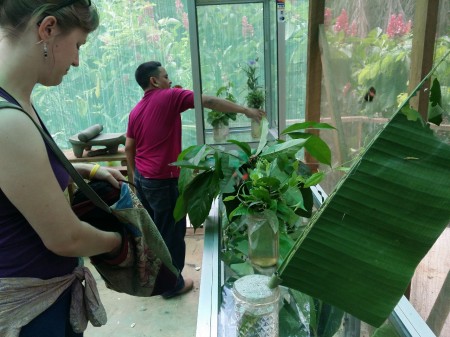
Jose was eager to show us every aspect of butterfly reproduction that didn’t require a magnifying glass.
The second half of the tour was for the four legged fauna of the island. Jose would gently call out into the trees, and some white-faced monkeys would drop onto the ground, or his shoulders (or our shoulders) and make some high-pitched beeping noises. “That means he is happy,” Jose said, and would hand the monkeys some sweet corn pellets he kept in his pocket. I had put a flower into Christine’s hair, and the largest monkey, Louie, immediately grabbed it and stuffed it into his mouth, grunting contentedly. So much for that. Other animals included the Koati Mundi, another free roamer, who was scratching for worms and bugs near a pathway, and ran up to Jose to ask for sweet corn, too. Kept in cages (“for the moment,” said Jose, “because they fight with the white-faced monkeys”) were the exotic spider monkeys with leathery tails and creepily long arms. Jose disappeared for a moment, then brought a huge-eyed Kinkajou, the “yellow monkey” out by the tail. The animal seemed entirely unperturbed; settling like a baby into Jose’s arms. The last “pettable” animal was an Aguti, who we were told was the largest rodent on the island – in this case, a 4-year old pleasant-tempered female who settled into my arms and started licking my hands for salt, just like the guinea pigs my parents used to raise.
After leaving Mayan Eden, we continued east to the odd-sounding “Arch’s Iguana Farm,” which had been recommended to use by one of Chris’s employees, who told us his uncle was Arch, the owner. After going off the main road onto a gravel road for a couple of miles, we walked down a flight of steps and into a slow-moving swarm of iguanas, sunning themselves on Arch’s rocks, roofs, and each other. Arch appeared a few minutes later, a very short and hunched elderly man, who greeted us pleasantly and handed us each a cocoa plant leaf and told us to give the lizards a special treat. Although they didn’t seem interested at first, when we moved our leaves next to one’s mouth, then suddenly all of his neighbors would notice and rush over. I asked Arch how on earth he had gotten started on such an unusual farm. He told me that he saw the lizards being killed by poachers and collectors a few decades ago, and started feeding them in an attempt to get them to come onto his land (“although they’re all free to leave; I don’t be havin’ no fences on my land to keep dem here,” he told me in his particular drawl, sounding a mix of Upper Michigan and Jamaican) and now, he estimated he had some 3,000. “That der’s Aggie,” he said, pointing up to his garage roof where a massive lizard was sunning herself. “She’s one of my oldest girls. Bout 28 I dink. Got about tenner so make it past 20, right now.”
Arch’s nephew at Tranquil Seas had told us that he accepted donations, to buy cabbages as the main feed for his scaly friends, but when I offered him the bills, he waved it away, and told us to have a nice lunch and tell our friends about the farm instead. His sing-song accent grew a bit dark, though, as he pointed out to an island a half mile to the south, though, and he told us that the man that had bought that island had opened a restaurant, “Key’s 44” and was poaching and stealing the lobster of the French Key Protected Zone for his restaurant. He and his neighbors had established the nationally protected zone with the local government, but now the new interloper was also dredging and damming up the reef in order to enlarge his island with concrete. He didn’t say it, but once again it seemed the bitterness was aimed at the Honduran government being toothless in stopping these foreigners from destroying the environment that he and his fellow native Islanders were trying to protect. Needless to say, although we passed the Key’s 44 restaurant on the way back to the west end of the island, we didn’t stop to eat there.
Christine, now a Master’s degree holder in Linguistics, was fascinated by the mix of languages that the Hondurans used on the islands – from mostly recognizable Spanish from the mainlanders, to a pidgin creole French/Spanish/English used by others, to the Jamaican-sounding English that the more European-looking natives used, the island is clearly caught between multiple ancestries. We were told that the island never had a “native people,” but instead was used as a pirate hangout by famous Caribbean marauders for centuries, then the Spanish took over and brought black slaves as well. Englishmen mixed in as well, and the island was given back to thoroughly-Spanish Honduran mainland only a hundred years ago – much to the chagrin of the islanders, for the reasons mentioned above. We were told multiple times that it would be a great place to move to and settle down (mostly by expats, granted) and that a couple could live here for only $1000 a month, plus another $200 a year in taxes. Judging by the price tags we saw on plots of land at the side of the road, establishing yourself here was the only main expense!
Once we get back to Christine’s place tonight, hopefully I’ll find the time soon to offload some pictures of the island and publish this last blog entry.
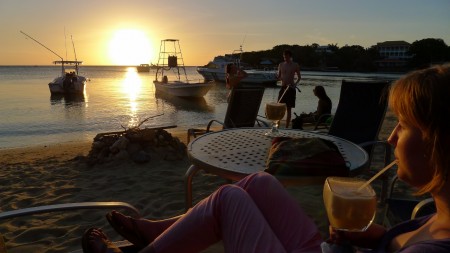
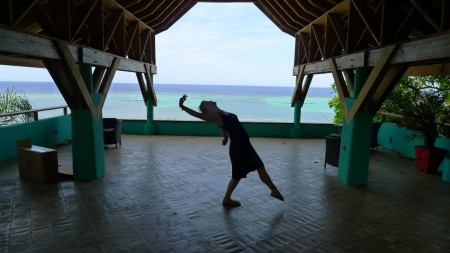
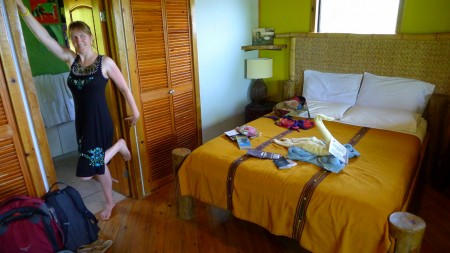
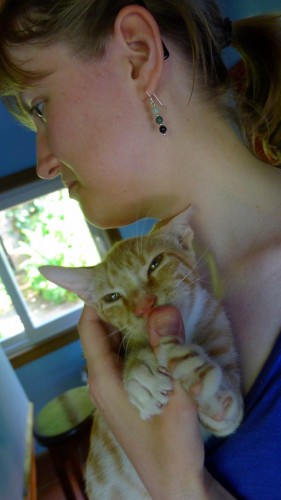
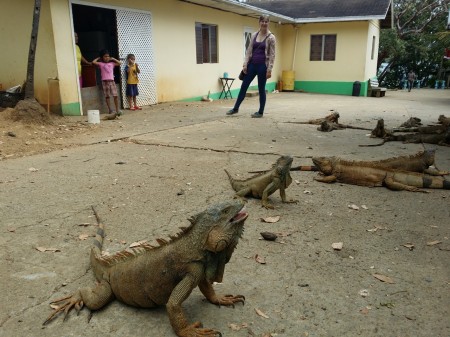
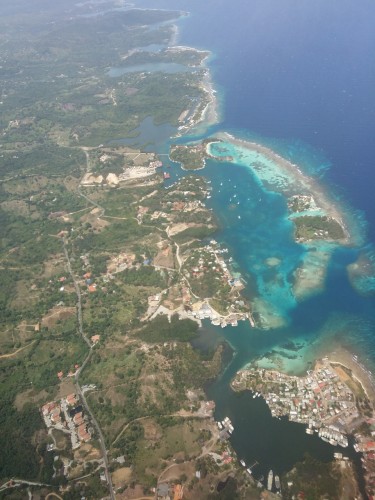


No one has commented on this post - please leave me one, I love getting feedback!
Follow this post's comments, or leave a Trackback from your site